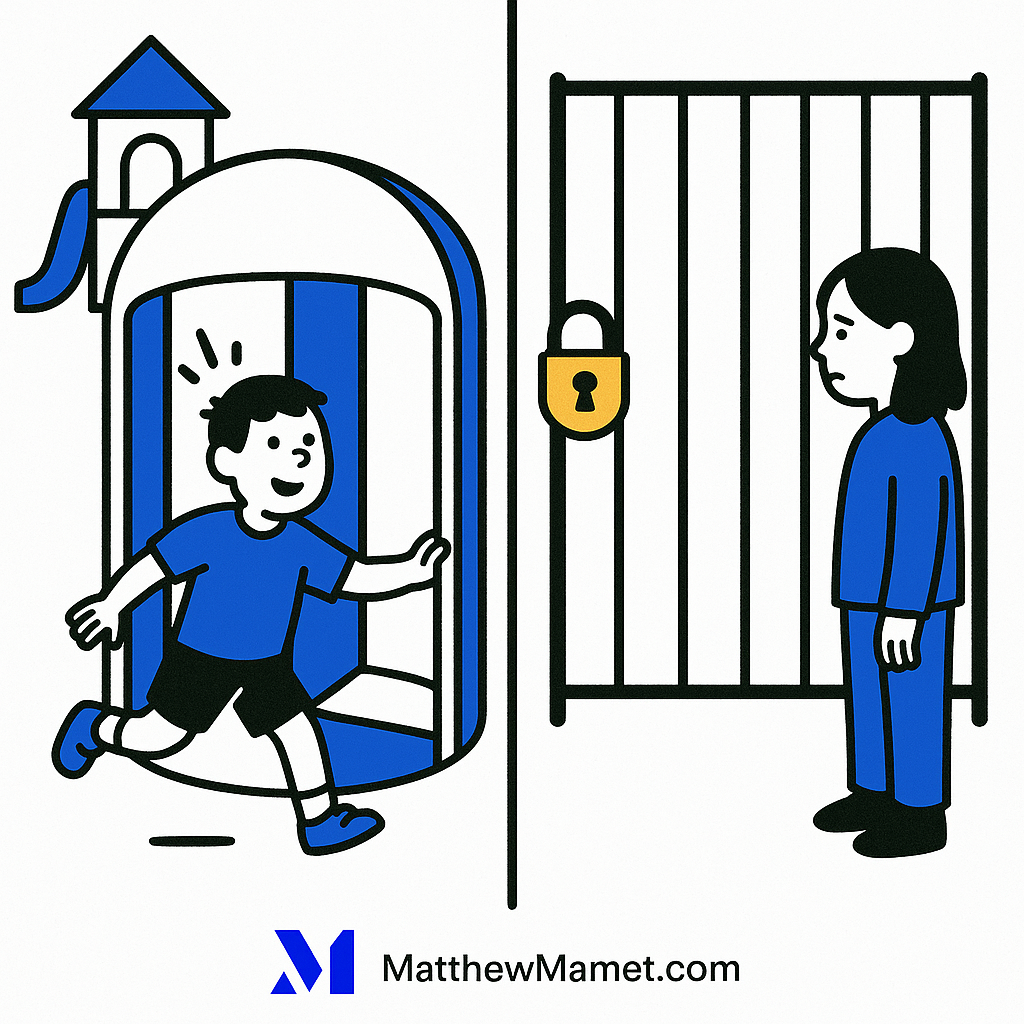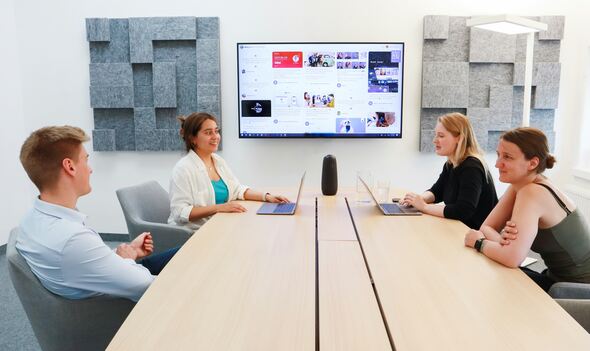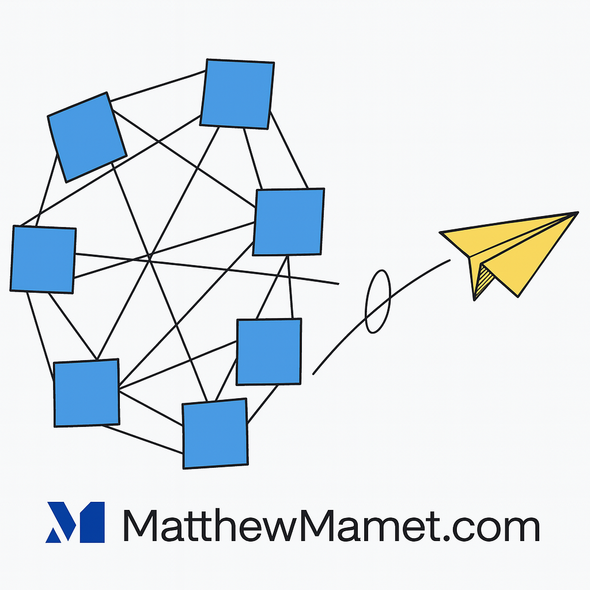Summary:
Business decisions should be classified as either one-way or two-way doors to determine their reversibility and urgency. One-way decisions, like selling a company, require careful deliberation, while two-way decisions, such as changing a website button color, can be quickly tested and reversed if needed. Emphasizing speed and adaptability in decision-making fosters a culture of action and learning.
Table of Contents
You're Not Performing Brain Surgery. You're Just Picking a Button Color - for now.
I once worked with a product lead who spent two full weeks trying to decide whether to change the CTA button on the homepage from blue to green. Endless Slack threads. A/B test setup delays. Debriefs. Counterpoints to the counterpoints. You’d think we were about to inject code into a rocket ship mid-launch.
The truth is, most decisions in business - especially in product, marketing, and hiring - aren’t irreversible. You can almost always test, tweak, rewind, or cut bait and move on. But we act like every call we make has to be thoroughly vetted by a Supreme Court. It’s nuts.
Here’s the core concept: Some decisions are one-way doors. Once you walk through, you can’t walk back. Think “sell the company,” “fire a key exec,” or “pivot industries.” Those deserve caution and heavy diligence.
But most decisions are two-way doors. You go through, see what’s on the other side, and walk right back if it sucks. And yet, people treat every choice like they’re detonating a bridge. That mindset creates unnecessary paralysis, bloats your product cycle, and confuses your team.
Classify the Decision First
I now coach every exec and team to do this: Label the decision before you make it. Ask, “Is this a one-way door or a two-way door?” It immediately changes your approach.
Two-way doors mean you can:
- Move fast
- Test small
- De-risk through iteration
- Get feedback in the wild
One-way doors mean you:
- Slow down
- Align with leadership and stakeholders
- Anticipate unintended consequences
- Document your thinking
- Test your thinking with others
It clarifies who decides, how fast you go, and whether you need plan B ready.
Ready to drive more growth & achieve bigger impact?
Leverage my 25+ years of successes and failures to unlock your growth and achieve results you never thought possible.
Get StartedTwo-Way Doesn’t Mean “Doesn’t Matter”
Here’s where people get it wrong. They think if a decision is reversible, it’s not important. Nope. Two-way door decisions can have major upside or downside. The point isn’t that they’re risk-free - it’s that they can be undone.
That CTA color? It affects conversion. That pricing test? It could hit ARR. That manager you promoted too fast? They’re now struggling.
But you can restore the old CTA, revert pricing next quarter, or coach/reassign the manager. You can fix it - in hours, days, or weeks. That's the point.
So act like it.
Here’s a quick reference to help shift your mindset:
| Type of Decision | Examples | Reversible? | How to Approach | Speed Needed |
|---|---|---|---|---|
| One-Way Door | Firing your VP Eng, M&A deal, replatform tech | No | Debate, align, document | Thoughtfully slow |
| Two-Way Door (high stakes) | Launching a new feature, repricing, hiring an early team member | Yes | Try, measure, iterate | Fast but intentional |
| Two-Way Door (low stakes) | UI change, onboarding quiz tweak, ad copy | Yes | Ship fast, watch metrics | Immediately |
Great Operators Know When to Slow Down - and When to Go
Every founder I’ve worked closely with who’s scaled fast had this superpower: they didn’t waste time on two-way matters. They kept energy focused on things that moved the needle and built feedback loops into everything else.
One CEO I coached used to frame it this way in team meetings: “What’s the worst that can happen? Okay, then ship it.” He built a product org with speed as the default, and just 2% of their experiments ever became problems. And those? They fixed them in a day or two max.
When I worked on the consumer side of marketplaces, we were constantly making UX changes, marketplaces tweaks, and tweaks to growth loops. Some of them flopped. Some crushed it. But the trick is, we didn’t bet the company on any one of them. We tested. We watched. We moved.
It’s the people afraid of looking “wrong” who clog everything up. Guess what: being wrong faster wins in the long run. You learn while everyone else is still polishing their memo.
That’s the playbook: match the speed to the reversibility. Not the ego to the spotlight.
Help Your Team Move Faster
Once you get this concept, spread it. Most teams are wired to ask “Are we sure?” way more often than “Can we try this quickly?”
Here’s what I recommend to reinforce the habit:
- Make “Is this a one-way or two-way door?” part of your product review checklist
- Encourage your team to label decisions that way in docs and meetings
- If it’s a two-way door, default to shipping, not debating
- If someone escalates a two-way door repeatedly, coach them on risk management
- Celebrate reversals as learning, not failure
Decision velocity is a huge driver of marketplace momentum. In systems with supply/demand dynamics, like B2C marketplaces, delays compound. A slow test on messaging for sellers means you’re 3 weeks behind validating value props - which means your supply acquisition engine limps for another month. That affects liquidity, conversion, and retention. All because people didn’t realize they could undo the decision they were afraid to make.
Related: you can spot high-impact people early by who asks “What can we test this week?” instead of “What’s the perfect strategy?”
Ready to drive more growth & achieve bigger impact?
Leverage my 25+ years of successes and failures to unlock your growth and achieve results you never thought possible.
Get StartedThe Real Trap: Death by Overweighting the Wrong Things
There’s a sneaky dark side to this - people often pretend reversible decisions are one-way because of status, ego, or fear.
I saw a product director once fight tooth and nail to stop a tiny design test because “our brand can’t afford the confusion.” It was a header change. We ran it anyway. CTR went up 11%. And we reversed it two weeks later to test something even better. Nobody remembered version A six days in.
This happens with titles, logos, feature names, navigation labels. Everyone wants to be right. But no one’s remembering your V1. They’re looking for value, and they don’t care how many drafts got you there.
One good read that lines up here? TripAdvisor famoulsy used speed as a growth advantage. It nails the psychology of how fast feedback loops help you win - not because you’re smarter out of the gate, but because you learn faster than your competitors do.
One More Thing: Use The Principle Across Roles
This isn’t just a product thing. Leadership calls, management style, hiring frameworks - same rule applies.
Should you let your IC lead the meeting next week? Try it. Didn’t go great? Debrief and do it differently. Not a one-way door.
Want to reorganize teams for a new initiative? Maybe reversible, maybe not. Ask the door-type question before you roll it out. Saves you the “oops” headcount drama.
Even telling someone you want to experiment with async updates instead of status meetings is a two-way door. Try it for 2 weeks. If people miss the sync, bring it back. No harm, no foul.
By the way, if you’re leading multi-level organizations, you’ll appreciate this perspective: stop controlling, start coaching. The message is clear - stop micromanaging and start enabling. The two-way door framing is a great tool for that shift.
Ready to drive more growth & achieve bigger impact?
Leverage my 25+ years of successes and failures to unlock your growth and achieve results you never thought possible.
Get StartedWrap-Up: Stop Acting Like Everything Is Final
Here’s what I want you to remember:
You’re not the Supreme Court. You’re running (or helping run) a living, breathing system that thrives when it iterates. Most decisions are two-way doors. Treat them that way, and you’ll move faster, learn more, and build a stronger culture of action.
Next time you’re hesitating on launching that new flow, trying a new headline, tweaking onboarding, or tweaking team rituals - ask yourself:
“If this bombs, how fast can we reverse it?”
If the answer is “within a sprint,” you’ve got your answer.
Now get going. Speed Wins.
Ready to drive more growth & achieve bigger impact?
Leverage my 25+ years of successes and failures to unlock your growth and achieve results you never thought possible.
Get Started



